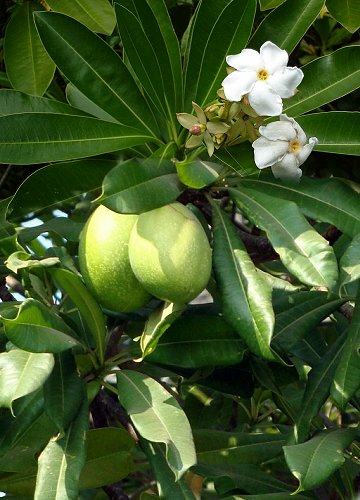
|
|
Suicide Tree
(Cerbera odollam). Flowers, fruits.
|
Suicide Tree - Cerbera odollam
Cerbera odollam is a dicotyledonous angiosperm, a plant species in the Family Apocynaceae and commonly known as the suicide tree, pong-pong, and othalanga. It is a species native to India and other parts of southern Asia, growing preferentially in coastal salt swamps and in marshy areas but also grown as a hedge plant between home compounds. It yields a potent poison that has been used for suicide and murder.
The genus is named after Cerberus because all its parts are poisonous. Cerbera odollam is known by a number of vernacular names depending on the region. These include othalanga maram in the Malayalam language used in Kerala, India; kattu arali in the adjacent state of Tamil Nadu; famentana, kisopo, samanta or tangena in Madagascar; and pong-pong, buta-buta, bintaro or nyan in Southeast Asia. In Sri Lanka, it is known as "gon kaduru" in Sinhala.
Cerbera odollam bears a close resemblance to oleander, another highly toxic plant from the same family.
It is a medium sized tree with smooth grey bark that grows approximately 10 meters tall. Its branchlets are whorled about the trunk, and its leaves are terminally crowded, with tapering bases, acuminate apices, and entire margins. The plant as a whole yields a milky, white latex.
Its fruits are green at first and turn bright red at maturity.
Its fruits, when still green, looks like a small mango, with a green fibrous shell enclosing an ovoid kernel measuring approximately 2 cm X 1.5 cm and consisting of two cross-matching white fleshy halves.
The dried fruits are 5-10 cm in length. When they fall from the branches, the papery, outer layer falls off exposing a thick fibrous husk. Because of this fibrous layer, the fruits are very light and buoyant, being easily dispersed by ocean currents.
On exposure to air, the white kernel turns violet, then dark grey, and ultimately brown, or black.
The fruits separate into two halves, each containing one seed. Which is why two separate stalks usually come out of this “seed” simultaneously.
C. odollam is native to India and other parts of southern Asia, growing preferentially in coastal salt mangrove
swamps and in marshy areas where the seeds are often washed up, but also being grown as a hedge plant between home compounds. Specifically, it grows wild along the coast in many parts of Kerala, India. It has been planted in Hawaii, and in other countries where it is not endemic, as an ornamental.
The fruits are used for manufacturing bioinsecticides and deodorants.Investigations have also been made into the feasibility of using the seeds as a feedstock in the production of
biodiesel.
The kernels of C. odollam contain cerberin, a digoxin-type cardenolide and cardiac glycoside toxin that blocks the calcium ion channels in heart muscle, causing disruption of the heart beat, most often fatally. The most common symptom of toxicity in humans was noted to be vomiting. Electrocardiographic abnormalities were noted to be common, the most common being sinus bradycardia. Around half of the patients develops thrombocytopenia. Temporary cardiac pacing has been used in the management, apart from other supportive
measures.
A fatal dose of the poison is contained in one kernel, leading to death within 1–2
days.
The difficulty in detecting cerberin in autopsies and the ability of strong spices to mask its taste makes it an agent of homicide and suicide in
India. In 2004, a team led by scientist Yvan Gaillard documented over five hundred different cases of fatal Cerbera poisoning in the late 20th century in the southwest Indian state of Kerala alone
(over a span of only ten years between 1989 and 1999).
So why is this toxin said to be almost undetectable ?
The difficulty in detecting cerberin in autopsies is simply because a fatal heart attack is usually assumed and that unless samples are tested by liquid chromatography and mass spectrometry
no-one will ever suspect poisoning, especially in people prone to heart-attacks. At least this is what I
read. I’m confused to how hours of vomiting and other awesome symptoms can be linked to a severe heart
attack.
Source:
https://en.wikipedia.org/wiki/Cerbera_odollam
http://www.culture-acre.com/surprising-tropical-plant-cerbera-odollam-suicide-tree/
